See also
- Artificial insemination
- Breed of bees
- Breed's of cows
- Breeds of pigs
- Calving cows. How to prepare for calving. Receiving calf
- Dairy breeds of cows and bulls. The productivity of dairy cattle
- Duroc
- Estimation of bulls on quality of posterity
- Hereford cattle
- Holstein breed
- Landrace - bacon pigs
- Limousin cattle breed
- Marble beef
- Mastitis in cows
- Meat breed of sheep, their characteristics and photo
- Meat breeds of cows and bulls. The productivity of beef cattle
- Simmental breed of cattle
- The Aberdeen-Angus cows. Description and characteristics of the breed
- The farrowing of pigs: preparing for farrowing, farrowing, care of a pig and piglets after farrowing
- The Yorkshire breed of pigs
- Vietnamese pigs. Description of the breed, breeding, maintenance and care
- What is the difference netel from heifers or cows?
- What is the meat yield in pigs — a mechanism to define and calculate deadweight
- Zootechnical rules
It's interesting
Dairy breeds of cows and bulls. The productivity of dairy cattle
Dairy products such as milk, yoghurt, cheese, butter, sour cream – are endless. These products occupy a huge value in the human diet, appear on our table thanks to the cattle. the Dairy cows is used not only for milk, but very often they are bred for meat production, despite the relatively small yield of meat from the carcass.
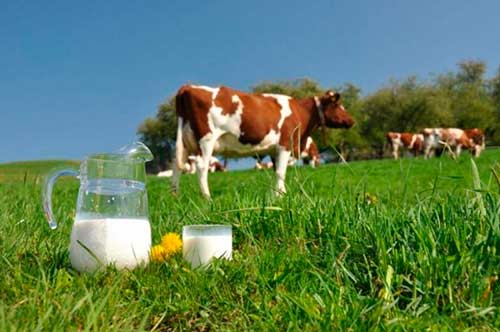
Dairy breed of cattle
Dairy breed of cattle. Features
Cattle dairy and meat cattle belong to a single species, but the differences between them are significant. Their productivity is due to different physiological features and characteristics of the exterior.
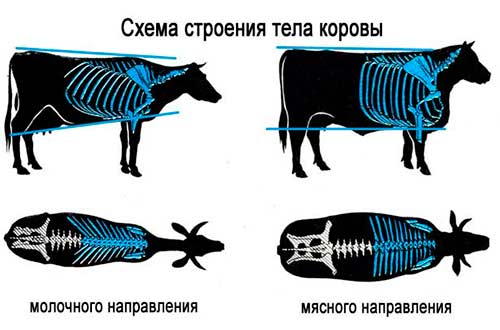
Diagram of the body of a cow
For dairy cattle, characterized by the following features:
- Elongated housing having the shape of a triangle with the base at the rear. This is evident when looking at the cow from the top or side.
- Lean body type with poorly muscled.
- Long, flexible neck (often with the skin folds).
- Straight back.
- fine bone structure.
- High foot.
- And the most striking feature of this is a large udder with large teats and veins stood out.
Cows of the dairy direction different calm and balanced character. Cattle adapted for stabling, pasture and mixed content. The digestive tract, cardiovascular and respiratory systems they are well developed.
To obtain large yields of milk a cow needs a balanced feed, providing nutrients, vitamins and minerals.
the Milk yield reaches its maximum after 5-6 calving. Depending on cow breeds in the first lactation productivity is about 60% of the average milk yield recorded in the herd of cattle.
Dairy cows
Dairy breeds of cows in a focused productivity differ primarily high yield. For some members of cattle in this direction, they exceed 10 tons of milk. The average productivity is in the range of 3-5 t
Ayrshire breed
The origins of the Ayrshire breed lie in the area of the same name in Scotland. Cattle is widespread in Eurasia, North America and Australia. This dairy cow is officially recognized as an independent breed in 1862
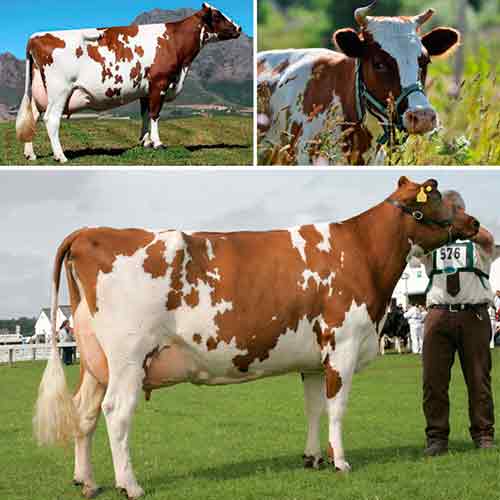
Ayrshire breed of dairy cattle
Cattle is perfectly adapted to the harsh climatic conditions. That is why cows predominate in Finland, displacing local milk varieties. The population, which diluted the Finnish breeders is one of the beautiful and productive characteristics: the average annual milk yield of the order of 8.57 tons of milk. The qualitative characteristics are quite high: the protein content to 3.44%, fat – 4,28%.
Cows are slightly cropped torso, lisoobrobna horns and red and white colors. Weight of adult productive females 590 kg. Body type typical of milk.
Dutch breed
Among dairy cattle have a long life span. Dutch cows for several centuries, bred pure or used to derive many of the zoned breeds.
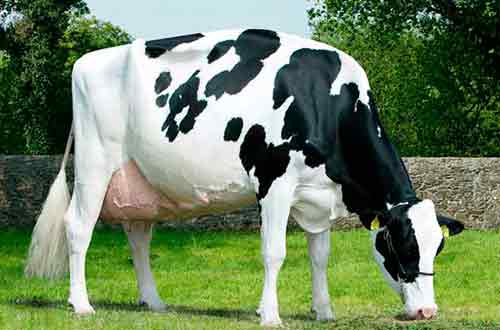
Dutch breed of dairy cattle
There are three types:
- Frisian. Dairy cattle, characterized by black-and-white coloring. Type is widely distributed and is the most characteristic of the Dutch breed;
- Groningen. Predominantly white-haired cattle, red or black color;
- Meuse-Rhine-Selska. You'll be dressed red and white colors.
Cows typical dairy conformation. In fact, they laid the Foundation for the selection of this direction in different countries.
Cows weigh up to 750 kg. Bulls are large, up to 1 t of Annual milk yield is 4.5 t Fat content of 3.5–4 per cent, protein in the range of 3.5%.
Holstein breed
Cow Holstein widely known in the world. Among cattle there are several types of animals that differ in productivity. In all countries their performance. This situation is connected with different priorities in breeding. When adapting cows to the local conditions will inevitably have been changes in the exterior, the ability to produce milk and build muscle.

Holstein cows
On the territory of Belarus are bred:
- black-and-white. The prevailing colors. Cow per lactation produce about of 7.34 t, in the milk fat of 3.8%. For comparison, in Israel they get more 10,0 tons milk yield. The fat content of approximately 3.7%;
- red-and-white, giving the order of 4.15 MT of milk with good performance the specific weight of fat (3,96%).
Cows weigh up to 750 kg, males often reach 1200 kg.
The Jersey breed
Among the cattle with the most fat milk stands out with the Jersey breed. Yield, compared with high-yielding breeds of cows, too, is small – 3-3. 5 MT per year. But the fat content of 5-6 %, often the figure comes to 7%. Due to this, the cattle milk is yellowish, with well-marked globules of fat. With a backlog quickly split into different factions. Cream and skim milk to form a clear boundary.
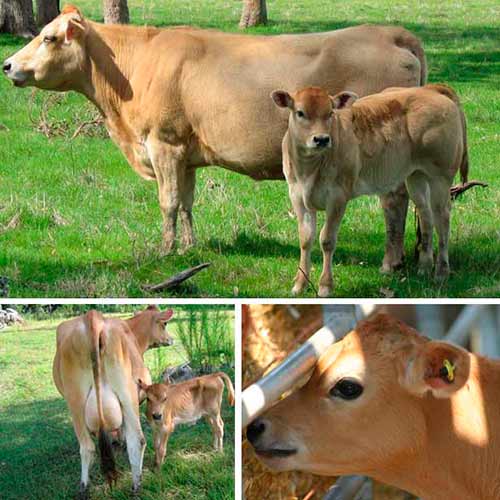
The Jersey breed of cattle
Dairy cows are medium-sized: the weight of adult female 360-400 kg, and the male is 600-700 kg. the Breed was developed by selective breeding on the basis of fat content in England, on the island of Jersey. As genetic material was used by local cattle of Normandy and the British varieties. The first stud book appeared in 1866
In many countries, and the former Soviet Union, in particular, the Jersey bulls used to increase the fat content of dairy products from local cows. While the meat is of low quality, no demand.
The breed has a short muzzle with a broad depressed head. In General, the Constitution of the milk. Most often cows are red. In the population there is a light brown species. There are with light and with dark spots and markings.
Red steppe breed
Red steppe breed cows has more than two hundred years of breeding history. The basis for the removal was the cows of the Ukrainian steppes. In 70-ies of XX in the characteristics of this breed of cattle improved using crossbreeding with the Danish and Angielskimi manufacturers. Red steppe is perfectly adapted to the arid climate, low maintenance.
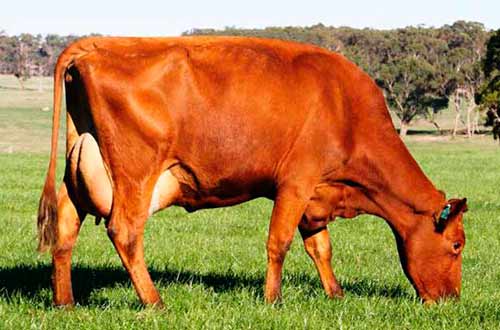
Red steppe breed of cattle
Despite belonging to the breed to dairy cattle, have a delicious meat. A cow typically weighs 470-520 kg. Bulls are large, up to 900 kg. With good feeding, the milk yield is stable, estimated at 3.5–4 t with the protein of 3.2–3.5% and the average protein content at the level of 3.7 to 3.9%.
The Red steppe owes its name to the area of cultivation and the prevailing colour in the population. The breed is distributed in the arid steppe regions. All cows are red, sometimes the chest or neck marked with white spots.
Kholmogorskaya breed
This is one of the aboriginal Russian breeds of dairy cattle. Native breed was formed with the efforts of national selection. Since the XVI century the three main types of dairy cows, razvalivshis in the Dvina district and called Kholmogory:
- black;
- black-and-white;
- white.

Kholmogorskaya breed dairy cattle
In the eighteenth century the first attempt of crossing with Dutch cows, but it did not bring success due to rather severe changes in weather and the climate. Therefore, in the nineteenth century they continued to mix with the Dutch and Holstein cattle. Already in 1927, was the stud book. Subsequently the breed was periodically improved the gene pool of a population of Dutch Friesian cows.
The Kholmogory breed is tall, proportional body milk with strong bones, deep chest and broad, slightly raised rump. In a population dominated by black-and-white coloring. Found a black and white suit, as well as red-colored and black.
Cows reach 590 kg, bulls – 950 kg. Per year you can get about 3.5–4 tons of milk, the average fat content is 3.6–3.7 percent. Limiting the protein content is 3.4%.
Black-and-white breed
Quite young dairy breed of cows, which appeared in the mid-twentieth century In the breeding farms of the Soviet Union crossed Ostrinsky and Dutch cow, finally got high-yielding dairy cattle. A distinctive feature of the breed – the possibility of delicious beef.
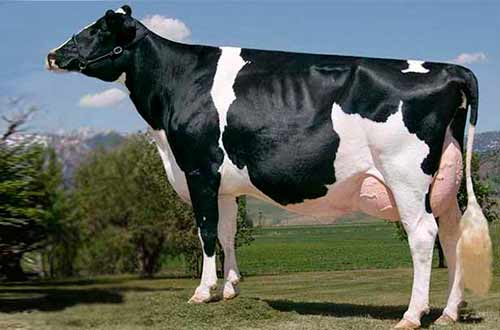
Black-and-white breed of dairy cattle
The live weight of cows reaches up to 650 kg, bulls – up to 900 kg, While milk yield is around 5 tonnes (per year). Products fat, 3,7–3,9%, with a high content of protein compounds, to 3.2 %. In the population are often records, when cows produce up to 8 tons of milk.
Appearance of representatives of black-motley breed of cattle can be described as milky. Cows are distinguished by the elongated head, rather short neck, grey horn. Udders with unequal lobes, Cup-shaped, the rear pair of teats situated close to each other.
The name "Black-white" was a consequence of the predominant colors in the population. Cows on the other suit is not found.
Yaroslavl breed
Slightly angular Yaroslavl cows have average body size and milk Constitution: body elongated, thin bones, short legs. In the rock is dominated by individuals with a black color. The body meet the characteristic white spots, marking the "points" (marks, highlighting the eyes), tip of tail, lower legs, and the stomach. The head is also often white.
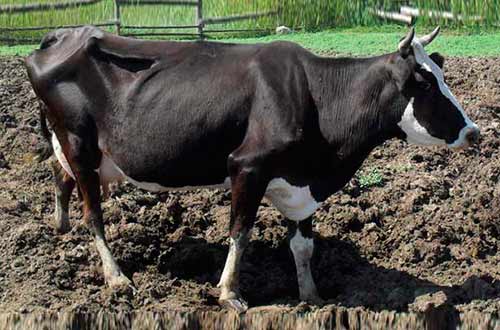
The Yaroslavl breed dairy cows
Native breed, bred in the XIX century, registered in 1924 In the future, when breeding was used and Ostrinskoe Holstein gene pool of the breed.
Cow-mid-size – in the range of 450-550 kg. Among the bulls meet real giants weighing up to 1.2 tonnes, although the average weight is 700-900 kg. Yaroslavl breed used for beef production. Meat has an acceptable taste. Calves grow quickly.
Primary productivity – milk. Cattle provide the 2.7–3.5 tons of milk. While in the rock recorded a lot of records. Under intensive feeding and good purebred material increasing yields to 5.5 tonnes per year. One of the cows showed a record at 11.59 tons of milk per year. It should be noted the high proportion of fat in dairy products, it is fixed in the range of 4.5%. Protein comes to 3.7%, the lower limit of 3.4%.
Comparison of productivity of breeds of dairy
All breeds dairy cows have their advantages and, of course, not without drawbacks. For example, in Belarus it is recommended to grow local, well adapted varieties or crossbred animals. Purebred European breeds show good productivity in our climate.
In addition, you must keep in mind that the duration of lactation, and, therefore, the average daily milk yield depend directly on the conditions of keeping and feeding. Genetic predisposition does not have a significant effect on these parameters, it all depends on the physiological characteristics. The period of lactation may be up to 300 days, the lower limit of 200 days is extremely rare.
To decide what breed of cows make on your farmstead, you can take as a basis the following information:
| name of the breed of cattle | fat (%) | protein Content (%) | Average annual milk yield (MT) | Possibility of cultivation in Russia |
|---|---|---|---|---|
| Ayrshire | 4,28 | 3,44 | 8,57 | +* |
| Dutch | 3,5~4 | 3~3,5 | 4,5 | – |
|
Holstein cows. Including: red-colored black-white |
3,96 3,8 |
3,4~3,7 3,4~3,7 |
4,15 of 7.34 |
+* +* |
| Jersey | 5~6 | 4 | 3,0~3,5 | – |
| Red steppe | 3,5~4,0 | 3.7 V~3,9 | 3,2~3,5 | + |
| Kholmogorskaya | 3.6 V~3.7 V | 3,3~3,4 | 3,5~4,0 | + |
| Black-white | 3.7 V~3,9 | 3,2 | 5,0 | + |
| Yaroslavl | 4,4~4,5 | 3,4~3,7 | 2,7~3,5 | + |
* if you purchased breeding. These animals are fully adapted to the local climate and are in fact a local variant of the breed.
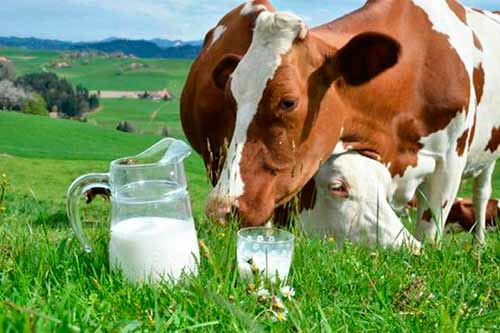
Dairy cattle
Despite the fact that in recent years the number of cattle is steadily declining, dairy cattle husbandry remains one of the most profitable. Selecting cows for household and providing appropriate care, you can forget about low-quality oil and milk hard cheese or a surrogate cheese.

